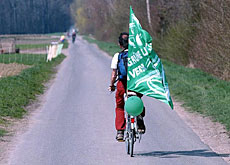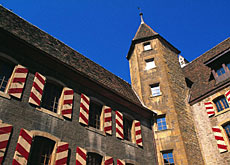Spring brings timely boost for the Greens

The Green Party has been going from strength to strength in regional and local ballots but remains a marginal player at a national level.
Experts say the Greens enjoy a reputation as an independent political force ahead of next year’s election to parliament and the cabinet.
Over the past two years, the Greens have been the big winners of cantonal elections, gaining an additional 35 seats in regional parliaments.
The Greens also emerged as the winners in the latest ballots in several regions, notably in Zurich and in western Switzerland.
The party is likely to consolidate its position in canton Bern, which goes to the polls on Sunday, and other regions where it had gained ground four years ago.
The latest results have taken the party to a new high in its relatively brief history of less than three decades.
“Voters seem to appreciate our fresh and straightforward way in politics. We are more independent than the centre-left Social Democratic Party which appeals to a similar electorate,” said Hubert Zurkinden, general-secretary of the Green Party.
He claims that the Greens are the only party which credibly combines environmental and social issues.
Outside mainstream
The group saw a first strong phase in the Eighties but success later levelled off.
Hans Hirter, senior political scientist at Bern University, says the Greens benefit from their reputation as an open-minded opposition party which stays out of the squabbles between the four main parties.
“On top of that the Greens are strong because their rivals are weakened as is the case of the centre-right Radicals or because voters apparently don’t want a single party – the Social Democrats – to become too dominant.”
Hirter says the different factions within the Green movement appeal to a large electorate – a view confirmed by Daniel Kübler, assistant professor for Swiss politics at Zurich University.
“The splits within the Green party are even an advantage because the different wings can cover a wider range of political opinions. But if the Greens were to become a governing party, divisions would be more problematic, as the example of the rightwing Swiss People’s Party shows,” Kübler said.
Potential
Zurkinden estimates that his party could aim for eight to ten per cent of the vote in the next nationwide parliamentary elections in 2007.
“With a bit of luck we will gain an extra four seats,” he said. This would bring the total to 16 in the 246-member federal parliament.
Hirter’s estimate is more conservative; he says there are limits to the party’s potential.
“Switzerland’s party system with three centre-right and rightwing parties and a solid position of the Social Democrats makes a major swing towards the Greens unlikely,” he added.
Cabinet seat
Hirter is convinced that a seat in the seven-member government is out of reach for some time as long as the centre-right in parliament – which elects the cabinet – is opposed to it.
Eighteen months ahead of the election the Green Party says it is considering its options.
“It can’t be an aim in itself to become a governing party. It only makes sense if we can achieve our environmental and social goals,” Zurkinden said.
The cabinet is currently made up of the centre-right Radicals and the Christian Democrats, as well as the rightwing Swiss People’s Party and the centre-left Social Democrats.
swissinfo, Urs Geiser
The first regional chapter of the Green Party was founded in 1971 in western Switzerland to challenge the construction of a motorway.
In 1979 the first Green Party representative was elected to the federal parliament.
The Green Party is represented with 22 different groups in 19 cantons.
Over the past few years the party won increasing support among voters in cities and major towns across the country.
Federal government: No seat
Federal parliament: 12 out of 246 seats
Share of votes 2003 parliamentary elections: 7.3%
Cantonal governments: 6 seats in 5 of the country’s 26 cantons
Cantonal parliaments (2005): 167 out of 2,758 seats, up 35 since 2004

In compliance with the JTI standards
More: SWI swissinfo.ch certified by the Journalism Trust Initiative












You can find an overview of ongoing debates with our journalists here . Please join us!
If you want to start a conversation about a topic raised in this article or want to report factual errors, email us at english@swissinfo.ch.